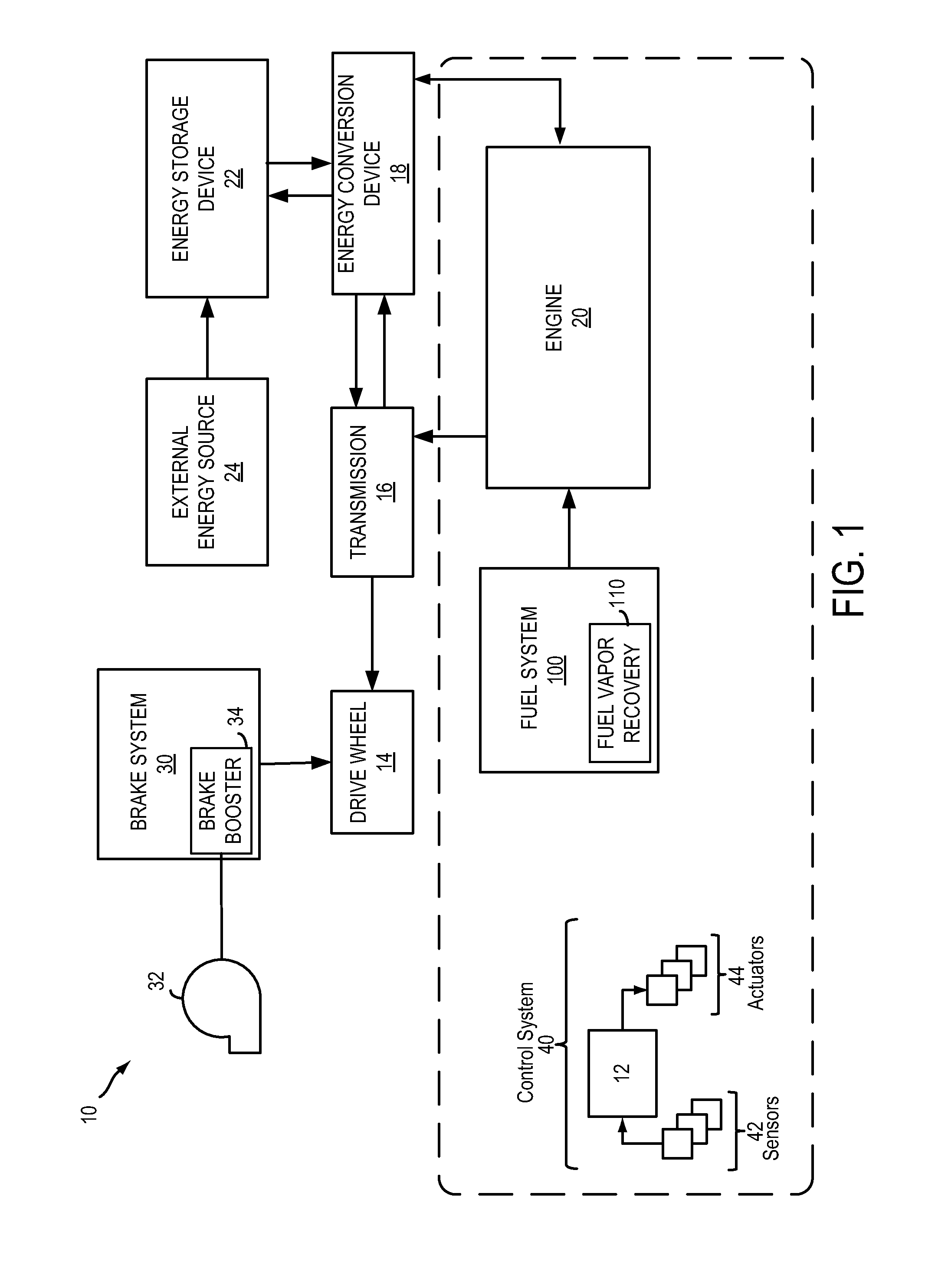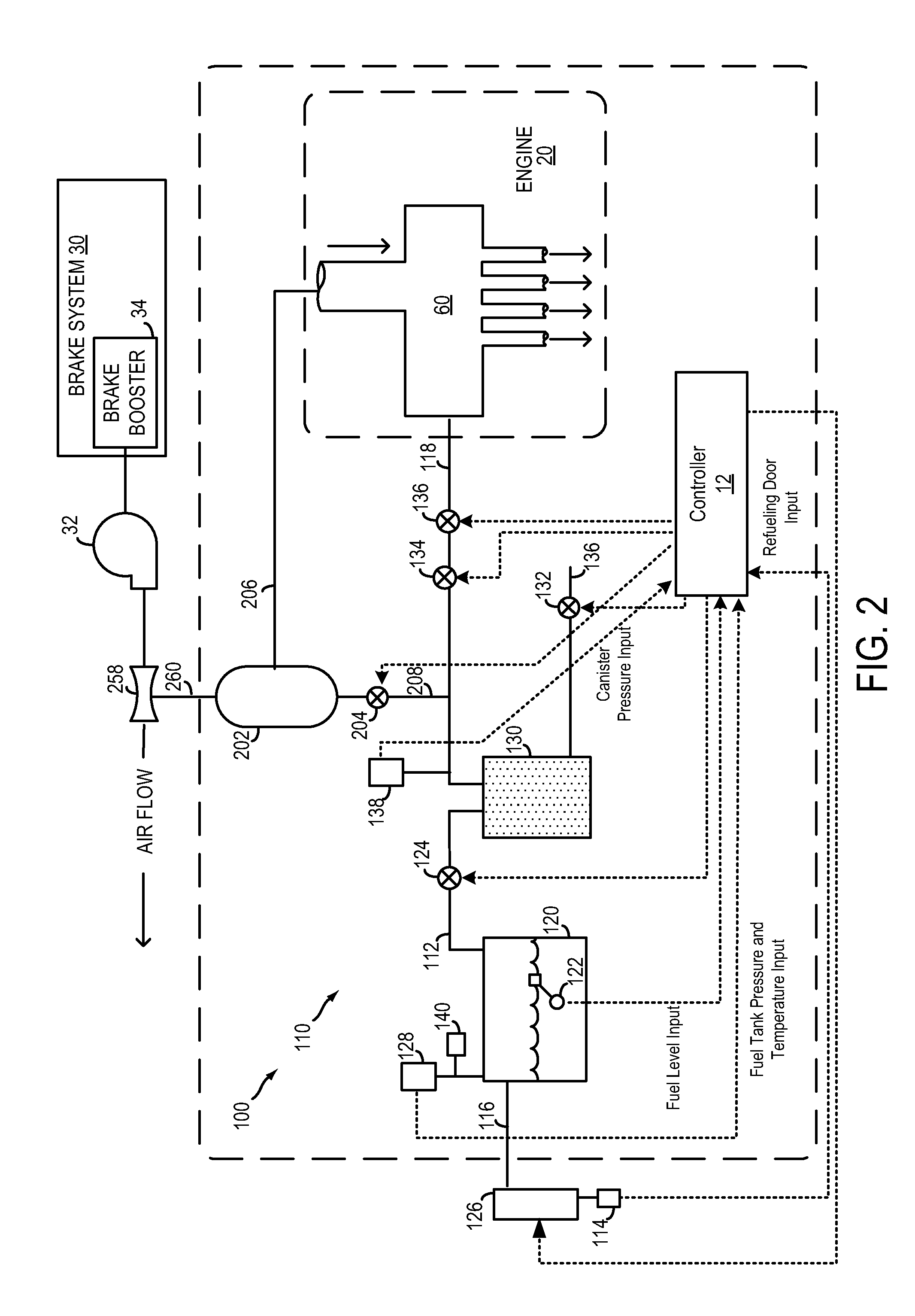Fuel oxidation reduction for hybrid vehicles
a hybrid vehicle and fuel oxidation technology, applied in the direction of condensed fuel collection/return, non-fuel substance addition to fuel, charge feed system, etc., can solve the problems of insufficient purging of fuel vapor from the vehicle's emission control system, refueling and emission control system leak detection operations dependent on pressure and vacuum, operation may also be affected, etc., to reduce the overall carbon emissions of the vehicle, shorten the engine operation time, and reduce the effect of engine operation times
- Summary
- Abstract
- Description
- Claims
- Application Information
AI Technical Summary
Benefits of technology
Problems solved by technology
Method used
Image
Examples
first embodiment
[0066]As the canister 130 is loaded with refueling vapors and sits over time, a condition may occur in which a negative pressure is created internal to the fuel tank. the present disclosure may comprise a pump 302. The vapors producing the negative pressure internal to the fuel tank may be pumped back into the fuel tank 120 to mitigate the creation of a negative vapor pressure within the fuel tank.
[0067]As plug-in electric vehicles need to have an external method of onboard (OBD) leak detection a pump that may operate as vapor pump 302 may be intrinsic to the vehicle and a controller 12 may comprise stored information to operate the pump to control for fuel tank pressure. For a pressurized leak detection system, running the pump would allow the HC vapors into the vapor dome of the tank.
[0068]In a variation of the first embodiment, a vacuum based system may be used in which vacuum pressure draws vapors back into the tank when a diverter valve opens between the fuel tank and vapor can...
fourth embodiment
[0078]NIRCOS fuel tanks may be designed to withstand a 45 kpa positive pressure and a 21 kpa negative pressure. the present disclosure may allow a NIRCOS system to use a current production fuel tank (designed to 3 kpa negative pressure and 14 kpa positive pressure) with modifications to meet the more stringent NIRCOS requirements.
[0079]A method for operating the active pressure control device 700 of FIG. 10 is shown in FIGS. 11 and 12. Turning to FIG. 11, the method 800 starts at 802 when the DCM 704 reads the vapor pressure in the tank. The method proceeds to 804 where it is determined if pressure within the tank is within a predetermined range. The predetermined range may vary with the type or size of the fuel tank, or additional components within the fuel system. If at 804, if the pressure is within the predetermined range (YES) the method returns.
[0080]If the pressure is outside of the predetermined range (NO) the method proceeds to 806 where it is determined if the vehicle is o...
sixth embodiment
[0087]Turning now to FIG. 14, the present disclosure is depicted. To mitigate against a vacuum draw in the fuel tank, caused by either a significant temperature variation or barometric pressure change, a variable volume material 1104 would be used internal to the fuel tank 1102. At atmospheric pressure the material would maintain a defined volume. As vacuum pressure is asserted on the fuel tank, the variable volume material 1104 may expand and thereby maintain the fuel tank vapor pressure within a predetermined threshold. The expandable material may be passive and react to a pressure differential.
[0088]Variations or combinations of the above described embodiments are possible without straying from the present disclosure, including variations of the materials, shapes, alignment, or construction of the above described components. A method is disclosed comprising, when fuel tank pressure is below a threshold, routing vapors from a fuel system canister to the fuel tank to maintain the f...
PUM
 Login to View More
Login to View More Abstract
Description
Claims
Application Information
 Login to View More
Login to View More - R&D
- Intellectual Property
- Life Sciences
- Materials
- Tech Scout
- Unparalleled Data Quality
- Higher Quality Content
- 60% Fewer Hallucinations
Browse by: Latest US Patents, China's latest patents, Technical Efficacy Thesaurus, Application Domain, Technology Topic, Popular Technical Reports.
© 2025 PatSnap. All rights reserved.Legal|Privacy policy|Modern Slavery Act Transparency Statement|Sitemap|About US| Contact US: help@patsnap.com



